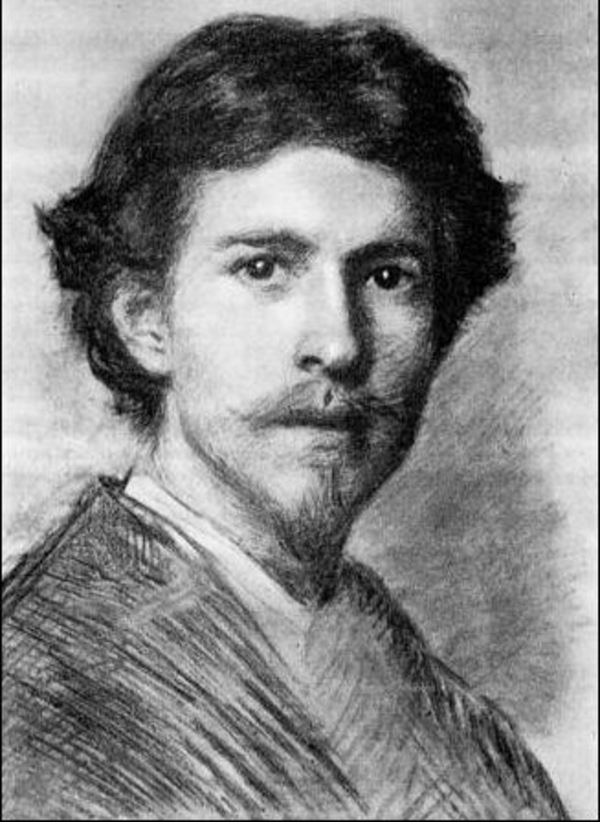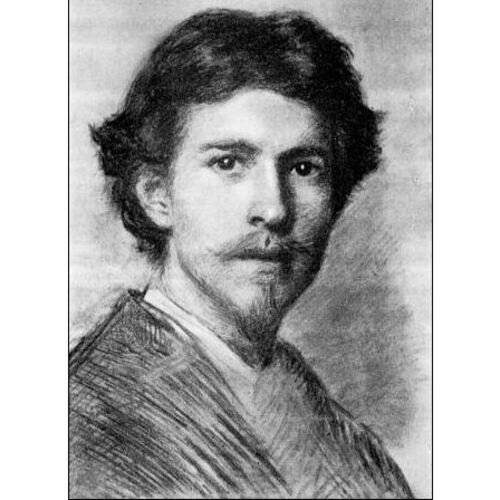
Source: Link
EATON, WYATT (baptized Charles Wyatt), painter, teacher, and author; b. 6 May 1849 in Philipsburg, Lower Canada, son of Jonathan Wyatt Eaton and Mary Smith; m. first 24 Sept. 1874 Constance Laure Papelard (d. 7 Feb. 1886); m. secondly 23 July 1887 Charlotte Amelia Collins; d. 7 June 1896 in Middletown, R.I., and was buried in Philipsburg.
Wyatt Eaton’s parents were Americans who had settled and done well in Philipsburg. Jonathan Wyatt owned a lumber business, and a carriage factory that shipped to Montreal and exported to New Zealand, and he became president of the Missisquoi and Rouville Mutual Fire Insurance Company. Respected in the community, he served for a time as mayor of Philipsburg. After working as a craftsman’s apprentice in his father’s carriage works, young Eaton began painting and drawing on his own, often copying the few landscapes, portraits, and plaster casts that were available locally. He took several of his drawings to Montreal. On the advice of William Lewis Fraser, a tinter of photographs for William Notman, Eaton enrolled at the National Academy of Design in New York in the fall of 1867. His instructors, most of whom painted portraits, included Emanuel Leutze, one of America’s foremost history painters. He also studied privately for five years with Joseph Oriel Eaton (no relation), a noted portrait specialist.
Eaton returned to Philipsburg in the summer of 1868. He received portrait commissions from local patrons and painted rural landscapes and figure subjects. One client was John Carpenter Baker, a Stanbridge banker and patron of the arts, who also encouraged Eaton’s slightly older contemporary Allan Aaron Edson*; as with Edson, Carpenter provided the funds that, in 1872, enabled Eaton to study in Europe. He stayed briefly in London, where he admired the later landscapes of Turner and met the American expatriate painter Whistler. Moving on to Paris, he enrolled in October in classes at the École des Beaux-Arts under Léon Gérôme.
At the time the dominant style in French art was that of the Barbizon painters, among whom Jules Bastien-Lepage and Pascal-Adolphe-Jean Dagnan-Bouveret influenced Eaton. The student found his most vital source of inspiration in the work of the acknowledged master of the school, Jean-François Millet, whom American artists in Paris had taken to visiting at his home in Barbizon. On viewing Woman sewing by lamplight (1872), in the spring of 1873, Eaton was so impressed with Millet’s approach to genre painting that he spent the summer at Barbizon. However, it was only shortly before he returned to Paris that he met Millet. He went back to Barbizon that winter and in the summer of 1874, forming a close friendship with Millet that endured until the latter’s death the following year. The relationship was natural, noted Will Hickock Low, who was with Eaton in Barbizon in 1873 and 1874; “absolutely earnest and simple in his affection,” Eaton had an “engaging personality that provoked a return of the sentiment.” Eaton’s first major genre piece, Harvesters at rest (1874–76), was greatly influenced by Millet’s peasant imagery; indeed Low felt that “for some years [he] fell into a quasi-imitation of the master’s work.” Nevertheless, Eaton ultimately developed his own realist style, which combined Millet’s naturalism and Gérôme’s precise, academic technique.
Eaton came back to Philipsburg in 1876 and for a few months painted portraits, locally and in Montreal. In January 1877 he returned to New York, where he joined the faculty of the Cooper Union. There, until 1882, he would teach drawing and portraiture and lecture to students and the public on Millet’s life and artistic philosophy. He soon earned high praise from students and critics alike for his sensitive approach to his subjects. In 1877 the successful showing of Harvesters at rest at the annual exhibition of the National Academy of Design brought him the notice of many of the city’s leading cultural figures, including Richard Watson Gilder, managing editor of Scribner’s Monthly (New York). Both Gilder and Eaton were discouraged by the prevailing attitudes toward art education in the United States and especially at the National Academy of Design, where hanging policies penalized young artists. Eaton, “in his simple way, was liberally endowed with obstinacy,” noted Low, and to provide a more open forum, particularly for younger, French-trained artists, he did “yeoman’s work” with Walter Shirlaw, Mrs Helena Gilder, Augustus Saint-Gaudens, and others to found the Society of American Artists in 1877. Eaton was the first secretary of the new organization and in 1883 served as its president. None the less, he continued to exhibit at the annuals of the National Academy of Design until 1890. During the 1880s and in 1892 he also sent portraits and genre pictures to the annual exhibitions of the Art Association of Montreal [see William Notman], and through it he was instrumental in introducing the Barbizon style to that city.
In New York, Eaton was in high demand as a portraitist. His reputation increased with the success in the late 1870s of a series of portraits of authors and poets – including William Cullen Bryant, Oliver Wendell Holmes, Henry Wadsworth Longfellow, and Ralph Waldo Emerson – which were engraved by Timothy Cole for Scribner’s Monthly. In 1878 the Parisian press favourably reviewed Harvesters at rest, which was on display at the universal exposition. During these years, Eaton spent his summers at Philipsburg, drawn to the rural ambiance of French Canada, which reminded him of Barbizon. He returned to France in January 1884, re-establishing contact with Millet’s family and focusing his creative energies on genre painting. One of his best-known works, The harvest field (1884–85), dates from this visit. In New York once more in 1886, Eaton somewhat reluctantly resumed his work as a portraitist. Around the same time, he began to explore other types of pictorial imagery, including classical and religious subjects as well as the nude (his Ariadne, of 1888, attracting wide critical acclaim). He continued to contribute to the popularity of Millet in North America through a major article in Century Magazine (New York) in 1889.
In late 1891 or early 1892 Eaton came back to Montreal where he was commissioned to paint portraits of such prominent Canadians as Sir John William Dawson, William Cornelius Van Horne*, Sir Donald Alexander Smith*, Richard Bladworth Angus*, and William Christopher Macdonald*. He also pursued his interest in Millet-inspired genre scenes (such as Plowing: Eastern Townships, 1894), often depicting the French Canadian habitant going about his daily routine. In 1895, following an illness and subsequent surgery, he travelled to Italy to recuperate. Rejuvenated, he went to London but was again plagued by ill health and soon returned to New York for treatment. In June 1896, however, he died of tuberculosis at age 47, and what had promised to be an influential career was cut short.
Although Eaton largely established his reputation as a painter, teacher, and writer within the tradition of late 19th-century American art, he played a notable role in the development of Canadian art as well. By making a trip to Europe in 1872, he, along with Edson, initiated a trend among Canadian artists; his contemporaries Paul Peel, Robert Harris*, William Brymner*, and George Agnew Reid* all subsequently felt the lure of Paris and French academic training, which reflected a new cosmopolitanism in Canadian and American art alike. Consequently he was also among the earliest Canadian artists to work in the Barbizon mode. In his portrait work, he was highly admired in both Canada and the United States for his ability to portray individual character, concentrating, in the words of the Canadian writer, editor, and art historian Newton McFaul MacTavish*, on “the form of the head and the spirit that showed in the eyes, keeping everything else in subjection.”
Wyatt Eaton is the author of “Jean-François Millet,” Modern French masters, ed. J. C. Van Dyke (New York, 1896), 179–95, and of “Recollections of Jean-François Millet” and “Recollections of American poets” in Century Magazine (New York), 38 (1889): 90–104 and 64 (1902): 842–50 respectively. The National Academy of Design (New York) and the Montreal Museum of Fine Arts hold self-portraits of Eaton; the Montreal portrait is reproduced in J. R. Harper, Painting in Canada: a history ([Toronto], 1966), 207. Another self-portrait appears in G. H. Montgomery, Missisquoi Bay (Philipsburg, Que.) (Granby, Que., 1950). The works by Eaton mentioned in the text are located as follows: Harvesters at rest at Smith College (Northampton, Mass.); The harvest field at the Montreal Museum of Fine Arts; Ariadne at the Smithsonian Institution (Washington); and Plowing: Eastern Townships in the collection of the Power Corporation of Canada (Montreal). The Art Gallery of Ontario (Toronto), the Art Museum, Princeton Univ. (Princeton, N.J.), Bowdoin College Museum of Art (Brunswick, Maine), Brooklyn Museum (New York), Chrysler Museum (Norfolk, Va.), McGill Univ. (Montreal), Musée du Québec, Museum of Fine Arts (Boston), National Gallery of Canada (Ottawa), Robert McLaughlin Gallery (Oshawa, Ont.), and Univ. of Mich. Museum of Art (Ann Arbor) also have works by him.
ANQ-E, CE2-87, 11 mai 1849. Art Gallery of Ontario, Library, Wyatt Eaton scrapbooks. New England Hist. Geneal. Soc. Library (Boston), Wyatt Eaton papers. New York Public Library, mss and Arch. Division, R. W. Gilder papers. Saturday Night (Toronto), 20 June 1896. DAB. Harper, Early painters and engravers. C. S. Macdonald, A dictionary of Canadian artists (3rd ed., 6v., Ottawa, 1987), 1. N. Z. Molyneaux, History, genealogical and biographical, of the Eaton families(Syracuse, N.Y., 1911). Standard dict. of Canadian biog. (Roberts and Tunnell), vol.2. Peter Bermingham, American art in the Barbizon mood: a visual history (Washington, 1975). J. A. M. Bienenstock, “The formation and early years of the Society of American Artists, 1877–1884” (phd thesis, City Univ. of New York, 1983). W. H. Gerdts, The great American nude: a history in art (New York and Washington, 1974). W. H. Low, A chronicle of friendships, 1873–1900 (New York, 1908), 110–18. N. McF. MacTavish, The fine arts in Canada (Toronto, 1925; repr. [with intro. by Robert McMichael], 1973). L. L. Meixner, An international episode: Millet, Monet and their North American counterparts (Memphis, Tenn., 1982); “Jean-François Millet: his American students and influences”
Cite This Article
Carol Lowrey, “EATON, WYATT (baptized Charles Wyatt),” in Dictionary of Canadian Biography, vol. 12, University of Toronto/Université Laval, 2003–, accessed January 22, 2025, https://www.biographi.ca/en/bio/eaton_wyatt_12E.html.
The citation above shows the format for footnotes and endnotes according to the Chicago manual of style (16th edition). Information to be used in other citation formats:
| Permalink: | https://www.biographi.ca/en/bio/eaton_wyatt_12E.html |
| Author of Article: | Carol Lowrey |
| Title of Article: | EATON, WYATT (baptized Charles Wyatt) |
| Publication Name: | Dictionary of Canadian Biography, vol. 12 |
| Publisher: | University of Toronto/Université Laval |
| Year of revision: | 1990 |
| Access Date: | January 22, 2025 |



